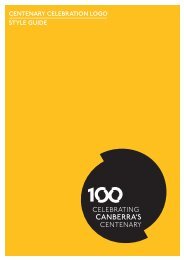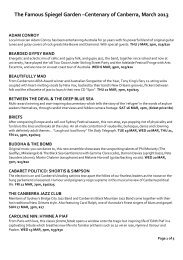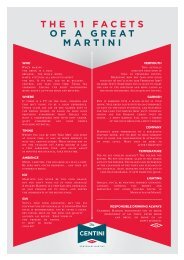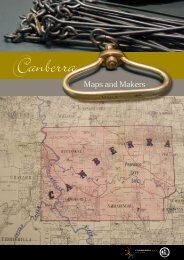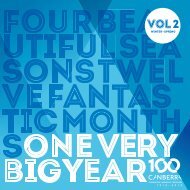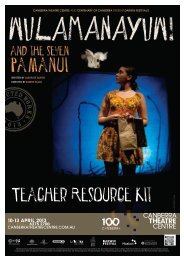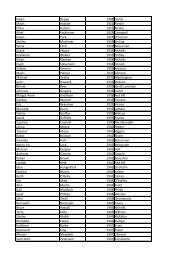THE ART - Canberra 100
THE ART - Canberra 100
THE ART - Canberra 100
You also want an ePaper? Increase the reach of your titles
YUMPU automatically turns print PDFs into web optimized ePapers that Google loves.
<strong>THE</strong> AUSTRALIAN CURRICULUM: MA<strong>THE</strong>MATICS<br />
••<br />
The Rationale says: Learning mathematics creates<br />
opportunities for and enriches the lives of all<br />
Australians… It develops the numeracy capabilities<br />
that all students need in their personal, work and<br />
civic life, and provides the fundamentals on which<br />
mathematical specialities and professional applications<br />
of mathematics are built… Mathematics aims to instil<br />
in students an appreciation of the elegance and power<br />
of mathematical reasoning. Mathematical ideas have<br />
evolved across all cultures over thousands of years,<br />
and are constantly developing. Digital technologies are<br />
facilitating this expansion of ideas and providing access<br />
to new tools for continuing mathematical exploration<br />
and invention. There are mathematical concepts<br />
involved in music and writing lyrics (Prime Time);<br />
any discussion with Eleanor Gates-Stuart and how<br />
she is creating StellrScope will include mathematical<br />
concepts; when casting a bronze sculpture, especially<br />
when scaling it up from a much smaller sculpture,<br />
mathematical concepts are involved (Icarus); when<br />
transferring a painting to a larger tapestry, mathematics<br />
is involved (the Untitled Tapestry, Parliament House).<br />
<strong>THE</strong> AUSTRALIAN CURRICULUM: SCIENCE<br />
••<br />
The Rationale says: Science provides an empirical way<br />
of answering interesting and important questions<br />
about the biological, physical and technological<br />
world… Science is a dynamic, collaborative and<br />
creative human endeavour arising from our desire<br />
to make sense of our world through exploring the<br />
unknown, investigating universal mysteries, making<br />
predictions and solving problems… In addition to its<br />
practical applications, learning science is a valuable<br />
pursuit in its own right. Students can experience the<br />
joy of scientific discovery and nurture their natural<br />
curiosity about the world around them. In doing this<br />
they develop critical and creative thinking skills and<br />
challenge themselves to identify questions and draw<br />
evidence-based conclusions using scientific methods.<br />
Scientific knowledge and skills have been used in the<br />
development of Icarus, the Untitled Tapestry and<br />
StellrScope.<br />
FUR<strong>THE</strong>R LINKS WITH <strong>THE</strong> AUSTRALIAN CURRICULUM<br />
••<br />
The general capability, ethical behaviour, whereby<br />
students develop ethical understanding as they<br />
learn to recognise and understand matters of ethical<br />
concern, make reasoned judgments and, in so doing,<br />
develop a personal ethical framework. This includes<br />
understanding the role of ethical principles, and values<br />
in human life; acting with integrity and regard for the<br />
rights of others; and having a desire to work for the<br />
common good. (The Australian Curriculum Shape<br />
Paper v.3) The acquiring of public art work, as well as<br />
the content within some of them (e.g Prime Time) and<br />
the context of others (funding of Big h<strong>ART</strong> in the Pilbara),<br />
offer opportunities for discussion and debate.<br />
••<br />
The General Capability, Critical and creative thinking,<br />
whereby students develop critical and creative thinking<br />
skills and suppositions as they learn to generate and<br />
evaluate knowledge, ideas and possibilities, and use<br />
them in combination when seeking new pathways<br />
or solutions. This includes learning to think deeply<br />
and broadly in activities that require reason, logic,<br />
resourcefulness, imagination and innovation in all<br />
learning areas. (The Australian Curriculum Shape Paper<br />
v.3) Each of the artists represented in this resource is<br />
a model for this capability.<br />
••<br />
The Cross-curriculum priority of Aboriginal and Torres<br />
Strait Islander histories and culture whereby all young<br />
Australians will be given the opportunity to gain a<br />
deeper understanding and appreciation of Aboriginal<br />
and Torres Strait Islander histories and cultures,<br />
their significance for Australia and the impact these<br />
have had, and continue to have, on our world. (The<br />
Australian Curriculum Shape Paper v.3) In the pages<br />
at the beginning of each subject in Phase 1, further<br />
information is supplied. This priority involves students<br />
actively engaging with the world’s oldest continuous<br />
living cultures and the principles and virtues that are<br />
deeply embedded within these communities. These<br />
principles include caring for Country, caring for each<br />
other and respecting the systems embedded in the<br />
concepts of Country and Place, People, Culture and<br />
Identity, including the links and lessons from the past.<br />
The priority provides opportunities for learners to<br />
understand the histories of Aboriginal and Torres Strait<br />
Islander peoples before colonisation and investigate<br />
the shared histories and resulting relationships since<br />
colonisation. AE MacDonald’s Early <strong>Canberra</strong> could be<br />
a starting point for looking at <strong>Canberra</strong>’s development<br />
and how local aboriginal history links with that. More<br />
significantly, Hipbone Sticking Out (Yijala Yala Project)<br />
relates deeply to this priority.<br />
ACKNOWLEDGEMENTS<br />
This education resource was written and developed by<br />
Chris Melican.<br />
Thank you to the following people who generously gave<br />
of their time for interviews or to help with information:<br />
Jan Brown, Eleanor Gates-Stuart, John Shortis, Debra Myer,<br />
Kylie Scroope, Sophie Chessell, Amanda Poland and<br />
Ann McMahon.<br />
Thank you to Dr Susanne Ilschner for her development<br />
assistance.<br />
REFERENCES/BIBLIOGRAPHY<br />
The Australian Curriculum Phase 1 (English, Mathematics,<br />
Science and History) www.acara.edu.au<br />
The Shape of the Australian Curriculum v.3<br />
www.acara.edu.au<br />
The Shape of the Australian Curriculum: the Arts<br />
www.acara.edu.au<br />
Fact Sheets provided by Parliament House<br />
Deborah Clark (Curator, 2008), Jan Brown, Sculptures,<br />
Prints and Drawings, <strong>Canberra</strong> Museum and Gallery<br />
ACT Government (2006 - 08) Arts <strong>Canberra</strong>: Action<br />
Statement for Public Art<br />
ACT Government (2012), Draft ACT Arts Policy Framework<br />
Professor Sir Ernest Gombrich OM (1960), Art and Illusion:<br />
A Study in the Psychology of Pictorial Representation<br />
The <strong>Canberra</strong> Times<br />
20 <strong>THE</strong> <strong>ART</strong> OF BRINGING <strong>THE</strong> <strong>ART</strong>S TO CANBERRA



